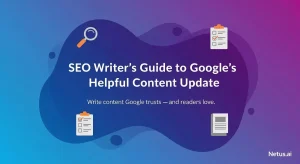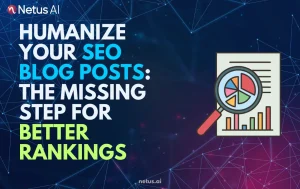
Why Google’s ‘Who, How, Why’ Framework Matters for EEAT | NetusAI
Why Google’s ‘Who, How, Why’ Framework Matters for EEAT AI can create articles in seconds. But here’s the truth: speed is not enough. Google wants
Content Similarity Detection: Unveiling Methods and Applications

Content writer and editor for Netus.AI
Content Similarity Detection. The advent of the internet and technological advancements has revolutionized the way people access information. Digital learning methods have undeniably transformed the lives of learners. However, the negative aspect of these advancements is the increasing challenge of duplicate content. Identifying identical content between two web pages is relatively easy, but the manual process of content similarity detection can be time-consuming and error-prone.
Plagiarism, the act of producing copied content, has become a significant concern, particularly in the academic field. It also impacts writers, content creators, and website operators, challenging their creativity and dedication. As a result, it is essential to develop effective strategies to avoid duplicate content and ensure the originality of one’s work.
Search engines strictly address plagiarism and duplicate content issues. They efficiently determine the original source and adjust search results to favor that site, negatively affecting the ranking of websites with copied content. Duplicate pages are often penalized and removed.
To avoid penalties, some websites modify their content slightly, making it difficult to identify the original source. Though this may maintain their SEO rankings, it can still be seen as a violation of intellectual property rights.
Content similarity detection tools are useful in these cases, identifying similarities and assisting in the prevention of accidental plagiarism. By being aware of copyright infringement risks and utilizing these tools, websites can maintain their intellectual property integrity and avoid the severe consequences of plagiarism in the realm of SEO.
Educational technology offers countless valuable resources for students, but unfortunately, it can also be misused. Many learners resort to unfair and dishonest practices when completing exams and research papers. This not only undermines the academic integrity of educational institutions, but also harms their reputation. It is crucial to prioritize authenticity and maintain a high standard for academic work.
Content similarity detection tools have become a valuable asset for educational institutions to detect plagiarism and maintain academic integrity. Through the use of machine learning and neural networks, these tools can analyze patterns in text and determine similarities between documents.
For example, users can upload two files they want to compare in a particular tool, and within a few minutes, the software highlights the matching text portions, making it easier to evaluate the content’s uniqueness. By leveraging technologies such as natural language processing, semantic analysis, and deep learning, content similarity detection tools provide accurate results and better assessment of text documents.
To prevent unintentional plagiarism, students need to master the art of creating original content. Here are some crucial steps:
By following these steps and conducting thorough cross-checking of their work, students can significantly reduce the risk of creating duplicated content and maintain the credibility of their academic writing.
Using a plagiarism checker is essential for web developers as it offers numerous benefits such as time efficiency and increased accuracy compared to manual plagiarism detection. Tools like these allow writers to identify the necessary adjustments required to modify and improve their work, thus avoiding plagiarism efficiently.
Some techniques, like citing sources, paraphrasing, utilizing synonyms, and restructuring sentences, are necessary to maintain originality in the content. Incorporating a plagiarism checker within a web development process also helps with privacy and optimization for search engine rankings.
Similarly, online grammar checkers contribute to improving writing quality by pointing out grammatical, spelling, and structural errors. As a result, creating engaging, error-free content not only enhances user experience but also supports a cost-effective marketing strategy by optimizing search results.
Content similarity detection tools are crucial to identifying plagiarism in instances where websites might use slightly altered or duplicate content for improved SEO rankings. They operate on the following principles:
This evaluation helps determine if the content is copied or original and minimizes the chances of false positives. Using content similarity detection ensures the authenticity and uniqueness of web content, maintaining a website’s credibility in the long run.
Websites can avoid plagiarism by implementing a thorough screening process for their content. This involves proofreading written materials and conducting copyright checks for various media types, such as images, music, and videos. This verification process ensures the content’s authenticity and helps prevent cases involving duplicate or copied content.
Website owners should also utilize tools that detect various forms of plagiarism, including copied ideas and paraphrasing. These tools assist in maintaining the website’s credibility and originality.
In addition, websites must protect their own digital content. They can achieve this by enforcing copyright protection, which limits unauthorized access to their material. This safeguards the interests of content creators and website operators alike.
Copyright is a legal measure that protects data and prevents misuse. Infringing on copyright can result in serious consequences, including monetary loss, for the offending party. By adhering to these best practices, websites can effectively avoid plagiarism and maintain their unique identity.
It is essential to follow a couple of best practices when using content similarity detection software to ensure effectiveness. These include:
Different content similarity detection tools vary in accuracy based on factors like the algorithm used, the size of the database, and the document type. It’s recommended to consider reviews, comparisons, and, if possible, test various tools before selecting one that meets your requirements.
To ensure your content is original, you can:
Content similarity detection algorithms work by analyzing text and identifying patterns that might indicate similarities between two documents. They often rely on techniques like fingerprinting, vector space models, and machine learning. These algorithms assess word usage, sentence structure, and other language patterns to determine the degree of similarity.
Although content similarity detection tools help identify similar content, they are not foolproof. Techniques like paraphrasing, altering sentence structure, or using synonyms can sometimes bypass these tools. However, advanced solutions continually improve to minimize false negatives and reduce the possibility of such manipulations.
Free content similarity detection services often come with several limitations, including:
Be aware of these limitations when choosing a free service to assess content similarity.

Why Google’s ‘Who, How, Why’ Framework Matters for EEAT AI can create articles in seconds. But here’s the truth: speed is not enough. Google wants

SEO Writer’s Guide to Google’s Helpful Content Update Keeping up with Google’s algorithm changes can feel like a relentless game of whack-a-mole. Just when you

Can AI Content Be Safe for SEO in 2025? Let’s start with the question of keeping every content strategist, SEO pro and blogger awake at

Humanize Your SEO Blog Posts: The Missing Step for Better Rankings You’ve done everything by the book. Your keyword research is impeccable. Your meta descriptions

How to Pass AI Detection Tests as an SEO Writer Let’s paint a familiar picture. You’ve just finished a blog post. The headline is sharp,

Why Your AI SEO Blog Isn’t Ranking (And How to Fix It) You embraced AI for your blog. The promise was intoxicating: high-quality content, published
@ 2024 Netus AI.